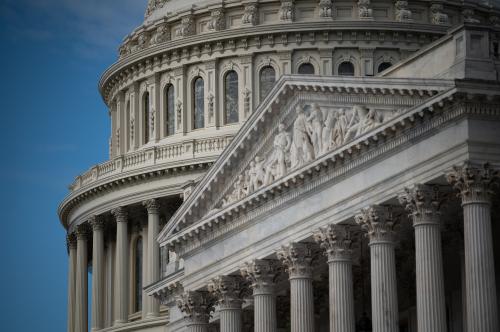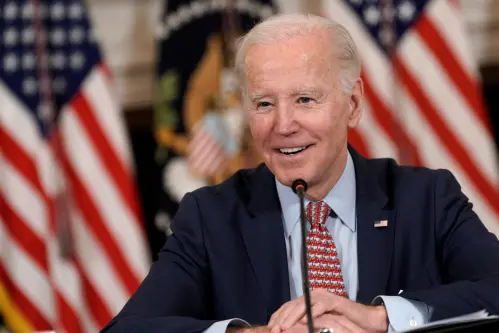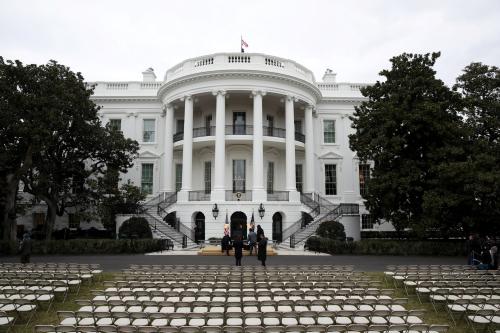This post is part of a series on the need for government reform and how to get it done. For more on this topic, visit the series page.
Joe Biden left the Democratic Party convention in August with the nomination and a “build-back-better” plan for clean energy, new jobs, closing the racial wealth gap, and economic renewal. He also left with the 110-page Biden-Sanders plan to restore Donald Trump’s budget cuts, reverse his regulatory rollbacks, attack corporate greed, combat the climate crisis, confront COVID-19, pursue environmental justice, repair the infrastructure, create jobs, and raise the minimum wage. “Folks, it’s not sufficient to build back,” Biden said in early July. “That’s why my plan is to build back better.”
Missing from the agenda is an equally ambitious commitment to the bureaucratic repairs that animated Jimmy Carter’s 1976 campaign. Biden’s website continues to promote his “Make-government-work-for-the-people plan,” but has not been updated to address the bureaucratic failures that emerged most obviously during the early days of the COVID-19 pandemic. Nor does the plan address the bureaucratic problems that undermine government effectiveness every day. Biden’s promised firewall between the White House and Justice Department and stronger whistleblower protections will signal change, but he has largely ignored the need for nuts-and-bolts repairs across government. Despite early signals that Democrats would pick up the government reorganization cudgel, big-ticket streamlining such as Elizabeth Warren’s proposed Department of Economic Development is still missing from the agenda.
Not only are grand reorganization plans missing from the campaign, but Biden also has yet to embrace overhauls at the many federal agencies that cracked during the early days of the continuing crisis. Although there is cause to focus on individual agencies in future legislation, the failures at the Centers for Disease Control, Federal Emergency Management Agency, Food and Drug Administration, Internal Revenue Service, and Small Business Administration demand a comprehensive approach. This is especially true given collateral breakdowns highlighted in the Government Accountability Office’s testimony before Congress in its inventory of threats to accountability in June.
Moreover, as former Democratic strategist and Washington Monthly columnist Ed Kilgore has warned, Democrats ignore the public’s distrust toward big government at their peril. Americans may want the bigger government and more services envisioned in Biden’s build-back-better agenda, but they also want a government that delivers on its promises with élan.
Over the next several weeks, I will pen a blog series here at FixGov that will make the case for a fix-government-fast reform agenda that provides a framework and game plan for a first Biden administration. Trump could adopt the agenda, too, but would need discipline to make it work.
This agenda will be laid out in seven posts as follows:
- My first post will examine the recent history of government breakdowns. Americans have come to their distrust of government performance because of one highly visible breakdown after another over the last 30 years. There have been plenty of government achievements over the years, but the successes have often been eclipsed by an attention-grabbing story about a broken government agency, failed program, or an executive gone wrong.
- My second post examines the public’s demand for very major government reform. Although this demand is linked to party differences, ideology, and demographics, it is also driven by public beliefs that the federal government is almost always wasteful and inefficient, does a poor job running its programs, and is run by a few big interests looking out for themselves. The recent surge in government breakdowns has also given Americans ample reason to wonder whether the federal government can faithfully execute even small-scale promises, let alone the grand promises on the Biden and Trump agendas today.
- My third post will discuss declining public support for Trump’s “burn-the-house-down” vision of major government reform.[1] Trump won the presidency as the champion of the “dismantlers” who say the federal government needs very major reform and a smaller government that delivers fewer services. Meanwhile, Trump has largely ignored the more moderate “streamliners” who favor limited reform and a smaller government, derided the “expanders” who favor a bigger government, and dismissed the “rebuilders” who support major reform and also want a bigger government. This post will show that the number of dismantlers has fallen more than a third over the past four years, while the number of rebuilders has increased by more than half. This post will assert that Trump cannot win without significant support from the streamliners, while Mr. Biden’s best chance is with the rebuilders.
- My fourth post will examine recent trends in bureaucratic bloat at the top of the federal hierarchy. Simply put, the federal government has never had more layers of leaders at the top of government nor even deployed more leaders per layer. The number of senior-level layers has quadrupled since Kennedy entered office in 1961, while the number of leaders in those layers has risen tenfold. Much as Trump complained about the “people over people over people” in government at the start of his term, he added record numbers to the total with predictable effects on missed signals and uncertain consequences up and down the chain of command.
- My fifth post will review the true size of the federal workforce in light of the Trump administration’s promises to winnow the bureaucratic bloat, freeze and cut federal employment, and promise to “cut so much your head will spin.” Despite early accolades for following through on cuts in the civil service, the Trump administration has presided over a massive increase in the federal government’s hidden workforce of contractors and grantees. Driven by spending for defense and transportation, the federal government’s blended workforce hit a near-record mark in 2019 and showed no signs of cresting.
- My sixth post will ask whether Congress and the president’s budget office still have the expertise—let alone the motivation—to craft the sweeping reforms needed to rebuild public confidence in federal performance. Both institutions still know how to pass laws to hunt down fraud, waste, and abuse in government and have drafted multiple laws over the decades to protect whistleblowers and create modest sunshine in government. Yet, they have not undertaken a major reorganization for decades, and America is now a half-century from the last major civil service repair. It is not clear that Congress and the White House could pull together a major reform package in Biden’s first term or Trump’s second even if the president wanted to.
- My final post will provide a short inventory of proposals that might give a future president a fighting chance at reform. The list starts with a nod to Jimmy Carter who stands as the last president to put government reform at the center of an administration. Notwithstanding Vice President Al Gore’s Reinventing Government campaign, which set an important precedent for delayering the federal hierarchy, bureaucratic reform has rarely been the stuff of presidential dreams. As this series suggests, however, Biden will have a much better chance at building back better if he also promises to fix government fast. The two are walking hand-in-hand this fall.
[1]. Mayor Pete Buttigieg used the term to describe Trump voters during late in his failed 2020 campaign for the Democratic nomination. See David Weigel, “The Trailer: What we learned about Buttigieg 2020 this weekend,” Washington Post, March 24, 2019.







Commentary
The case for major government reform and how Biden can make it happen
September 23, 2020